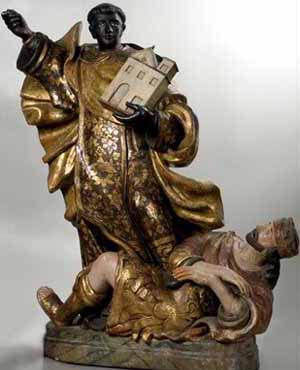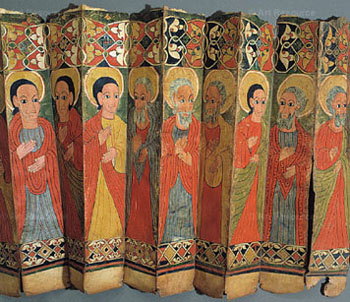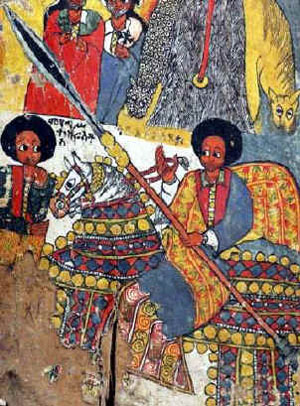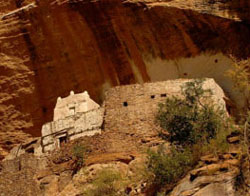 |
The Saint of the Day
St. Elesbaan - October 27
Prof. Plinio Corrêa de Oliveira
Biographical selection:
In the 6th century Ethiopia was ruled by the black King St. Kaleb or Elesbaan (after he became a hermit), who was raised from childhood in the Catholic Faith. King Elesbaan ruled his country with wisdom and was esteemed by his people.

St. Elesbaan defeating the impious King Dunaan
|
At that time Ethiopia was part of the Eastern Roman Empire, under Justinian I. Across the Red Sea, Arabia had fallen to Dunaan, a King who apostatized from the Catholic Faith and adhered to Judaism. He was a despotic ruler, persecuting the Bishops and clergy and destroying the churches or transforming them into synagogues. St. Gregentius, Bishop of Tafas, was expelled from his diocese;
St. Arethas, governor of Nadjran and leader of the Catholic reaction, was beheaded along with his wife, children and 340 of his people. Around 4,000 Catholics were killed without trial after suffering many cruelties.
Emperor Justinian called on King Elesbaan to chastise the usurper. The King gathered his army and crossed the Red Sea to punish the affront to Catholic honor. Elesbaan landed in Arabia, defeated Dunaan and executed him. Then he restored St. Gregentius to his episcopal see, rebuilt the churches and remained in the country until Ebrahamos, who was Catholic, was elected King of the Arabs.
Once his mission of justice and peace was accomplished, he returned to Ethiopia and ruled there for some years more, carefully instructing his son in the Catholic Religion and the direction of the Kingdom. Then he renounced his title and turned over the Kingdom to his son.
Disguised as a hermit, he retired to a monastery in the mountains. There he lived as a simple religious dedicated to prayer, obedience and work.
He died with a reputation of sanctity on October 27, 532. Often he is pictured as a solitary hermit holding a cross and with a crown at his feet.
Comments of Prof. Plinio:
I think the life of St. Elesbaan has a special beauty reflecting an aspect of the life of the Church that appears especially in the Eastern Catholic Church. This aspect is linked to a type of life that was frequent then, the lifestyle of the Anchorite or the Hermit – those early monks living in the desert, one of whom was St. Elesbaan. That solitary life in the desert was very beautiful, abounding in the supernatural, filled with light, and profoundly contemplative. It was shrouded in the prestige of solitude and mystery that surround those peoples of the East.

A ceremonial fan showing some of Ethiopia's many saints
|
Just as there is a special type of beauty that results when a grace touches Spanish souls bursting with life, and just as there is the beauty of the sublime when grace falls over French souls, so also there is a particular beauty when supernatural grace shapes the mentality of the peoples of the East, a beauty that we can discern in this life of St. Elesbaan. But it also causes sadness when we compare that old Catholic Ethiopia with today’s Ethiopia.
The Ethiopia of that time was ruled by a great Catholic King. He was the most important figure for the life of his country: a just ruler, a great warrior, a wise father who educated his son to succeed him on his throne. After abandoning the kingship, he retired to the desert.
This great King was also a crusader. The word crusader was not actually used in this selection, but he was a de facto crusader. Indeed, the religious persecution that had started in Arabia was instigated by a fanatic of the Jewish sect that was promoting errors and destroying the Catholic Church in southern Arabia, today’s Yemen. The Emperor of the Eastern Roman Empire, who was a kind of suzerain over the King of Ethiopia, ordered King Elesbaan to smash that error and to end the persecution.
On the west banks of the Red Sea, there was a Christendom established in Ethiopia where St. Elesbaan shone like a star. On the east banks was an Arabia where the cloud of error and fanaticism loomed. The Arabia of that time had many saints who – because they were faithful to the Catholic Faith – were persecuted, deposed or martyred.

An Ethiopian warrior preparing to enter battle
|
Then, a true crusader entered the picture, defeated the usurper, smashed the error, restored the Bishop to his diocese and reestablished order in that Kingdom of Arabia. It is the glory of Ethiopia to have had such a great King as St. Elesbaan.
This happened in the 6th century. Two centuries before, St. Frumentius had converted Ethiopia to Catholicism, and it became a fertile ground where many saints bloomed, one of them St. Elesbaan. In the 7th and 8th centuries, a good part of the Eastern Roman Empire – including Ethiopia – would fall under Muslim dominion. For many centuries, the religious situation was confused.
When Ethiopia emerged from that dark period, it was Monophysisist, as it is today. This heresy denies that Our Lord Jesus had two natures – human and divine – and pretends that He had only one nature (mono physis).
From the life of St. Elesbaan we can draw three conclusions:
First, we in the West often imagine that those Eastern peoples are not called to be a part of the Catholic Church. We have a tendency to consider the Church as a Latin phenomenon. This is absolutely wrong. Before our country [Brazil] was discovered in 1500, before Portugal was born in 1128, before any crusade was raised in the West – many centuries before all this – the Catholic Church was present in Ethiopia. A luminous Christendom was alive, shining with many saints and giving God much glory.
You can see, therefore, that all peoples have a vocation to belong to the Catholic Church. To be faithful to the Catholic Faith requires only one condition: to correspond to divine grace. Any people can reach its apex under the Catholic Church.

An ancient monastery outside the capital of Ashum - Abyssinia or Ethiopia
|
Second, in St. Elesbaan one can see the grandeur of solitude. He abandoned the throne with its glory and honors, along with his comforts and properties – everything – to find refuge in the desert. And it is as a hermit that St. Elesbaan remains in the memory of the Church through her iconography.
Third, his life gives us an example of the magnificent role of the black race, the black psychology, as an element of culture in the world. To understand the vocation of the black people, we should not think of the pragmatic blacks like many of those we see in the United States who crave to be modern, keeping up with Western fashions and modern technology. Rather, we should imagine the black Magi King, Balthazar, who followed the Star from the East to the Manger to pay homage to the Divine Infant. This King in fact represented a large part of the Gentiles. He is a figure of great prestige, mystery and elevation of spirit.
St. Benedict the Moor is often called the patron saint of the black people. He was a holy Franciscan monk and great saint, and we should certainly have recourse to him also. But I don’t know why so little is said about St. Elesbaan – who was a King, a wise man, and a warrior. Perhaps those who promote a sentimental piety do not like to speak of him because he was royal and militant… We should make an effort to counter this erroneous agenda.


  | | Prof. Plinio Corrêa de Oliveira | |
The Saint of the Day features highlights from the lives of saints based on comments made by the late Prof. Plinio Corrêa de Oliveira. Following the example of St. John Bosco who used to make similar talks for the boys of his College, each evening it was Prof. Plinio’s custom to make a short commentary on the lives of the next day’s saint in a meeting for youth in order to encourage them in the practice of virtue and love for the Catholic Church. TIA thought that its readers could profit from these valuable commentaries.
The texts of both the biographical data and the comments come from personal notes taken by Atila S. Guimarães from 1964 to 1995. Given the fact that the source is a personal notebook, it is possible that at times the biographic notes transcribed here will not rigorously follow the original text read by Prof. Plinio. The commentaries have also been adapted and translated for TIA’s site.
|
Saint of the Day | Home | Books | CDs | Search | Contact Us | Donate

© 2002- Tradition in Action, Inc. All Rights Reserved
|
 |

|